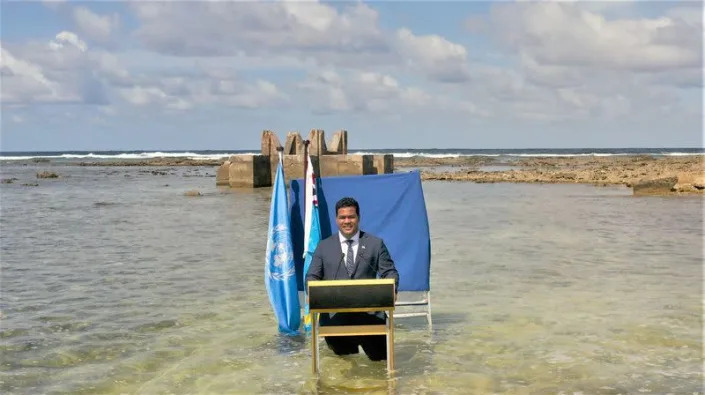Ross K. Baker
Sat, May 14, 2022
My dad was what was referred to in those days as a "fellow traveler." He wasn’t a card-carrying member of the Communist Party, but he followed the party line. I remember accompanying him as he delivered copies of the Daily Worker to comrades in the neighborhood. And one of the decorative touches in our house was a portrait of Joseph Stalin that hung on a bedroom wall until the period in the 1950s when Wisconsin Sen. Joseph McCarthy's well-publicized hunt for communists in various corners of American life convinced my dad that the better part of valor was to take it down.
My dad's affection was less for Stalin than it was for the people of the Soviet Union and the terrible price they paid to defeat the armies of Adolf Hitler. He revered the Russians as a heroic people, and part of that rubbed off on me even when I became old enough to understand that a noble people could be led by ignoble men and, worse, that they had the power to obliterate my country – so I accepted the reality of the Cold War while reserving a hidden corner of my heart for the brave people of Russia.
Russians deserved my sympathy
While I found the leaders of the USSR colorless and uninteresting men with the exception of Nikita Khrushchev, they never seemed especially sinister or threatening: just a bunch of stony-faced functionaries in mohair topcoats and fedoras standing on a reviewing platform in Red Square saluting columns of men and missiles.
Ukrainians' courage: Now the world must act to honor their bravery

A man holds a poster with half portraits of Soviet leader Joseph Stalin and Russian President Vladimir Putin, during a protest in front of the Russian Embassy in Berlin, Germany, in 2014.
It was only when the works of Alexander Solzhenitsyn became available and the dreadful word "gulag" entered our vocabulary that I began to think of Russians more as victims than as heroes and Russia as a place that harbored terrible secrets. Nearly a million Russian citizens were executed at Stalin's behest. Many more were severely mistreated. And his campaign triggered a famine in which millions of Ukrainians starved.

Russian Communist Party supporters hold portraits of Soviet leader Joseph Stalin as they gather in Moscow in 2018.
But if their leaders were ignoble, the Russian people were long-suffering and deserving of my sympathy, not my scorn.
New face, same Russian misrule
My compassion for the Russians deepened when I visited Russia after the collapse of the Soviet Union and witnessed a once-proud people reduced to begging, and I cringed seeing soldiers and sailors of a once-mighty military selling their caps, blouses and belts in Red Square and taking bribes from foreign tourists to allow them to enter Vladimir Lenin’s tomb after visiting hours.
When Vladimir Putin came along, I thought the Russian people had finally caught a break. The fact that he was a former KGB officer I didn't find especially alarming because Russia was always honeycombed with spies and informers. Putin, moreover, was a colorless man who didn’t seem especially sinister and a great deal less embarrassing than the drunkard Boris Yeltsin who preceded him.
But when the poisonings of dissidents with polonium and Novichok began and became weapons to punish dissidents, and journalists were shot down near Red Square, Putin came to look less like a savior and more like just one more sinister figure in a long history of Russian misrule.
Unspeakable cruelty unleashed
Any residual respect I had for the Russian people withered this year when I began to see images and hear Ukrainian testimonies of the people of Irpin and Bucha under attack and occupation by the Russian army.
Whether acting under orders or as renegades, ordinary Russian soldiers unleashed a campaign of unspeakable cruelty on the innocent civilians of a country much like their own, mouthing absurd slogans in defense of their barbarism that they were hunting down Nazis. This reign of terror seemed spontaneous and not coerced by commanders.
This is when it became impossible for me to reconcile my youthful admiration for the Russian people, as Russian fighters inflicted atrocities on defenseless men, women and children. The Russians had become transformed from heroic and long-suffering victims into the very fascists their ancestors had fought against so valiantly eight decades ago.
What little affection I have for Russians is reserved for those who opposed Putin’s unjust war and fled the country. But what troubles me most deeply is that there is something in the national character of Russia that produces in large numbers of their young men a malicious impulse that leads them to inflict widespread brutality on people who never harmed them.

Ross K. Baker
I understand the rage that can come from a desire for vengeance, but this is not at issue in the dreadful carnage that they have inflicted on the blameless people of Irpin and Bucha and dozens of other towns and villages in Ukraine.
No historic injustice or humiliation inflicted on the Russian people can justify the pain and suffering their fighters are inflicting now on the innocent people of Ukraine.
Ross K. Baker is a distinguished professor of political science at Rutgers University and a member of USA TODAY's Board of Contributors. Follow him on Twitter: @Rosbake1
You can read diverse opinions from our Board of Contributors and other writers on the Opinion front page, on Twitter @usatodayopinion and in our daily Opinion newsletter. To respond to a column, submit a comment to letters@usatoday.com.
This article originally appeared on USA TODAY: Russian barbaric rage of war in Ukraine changed my view of Russians

































